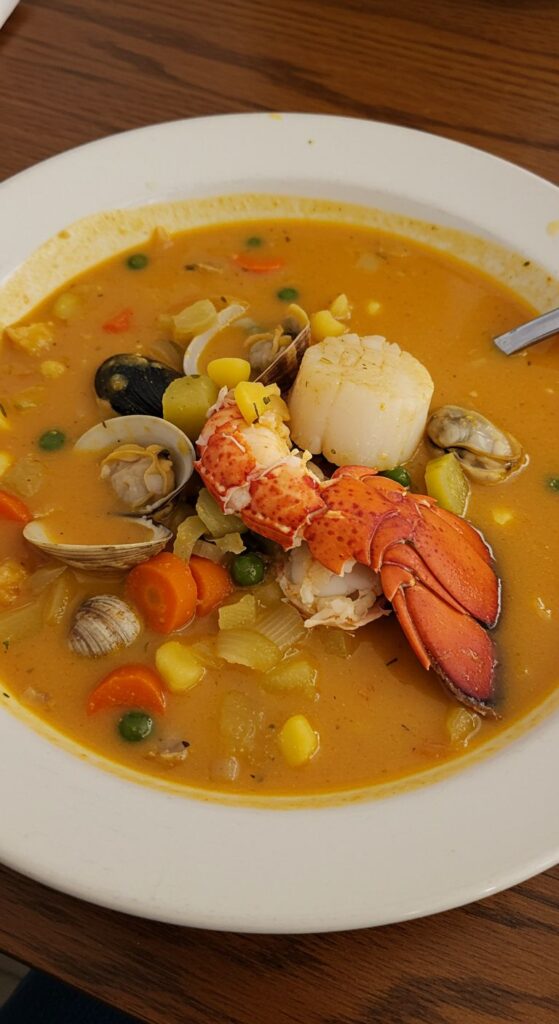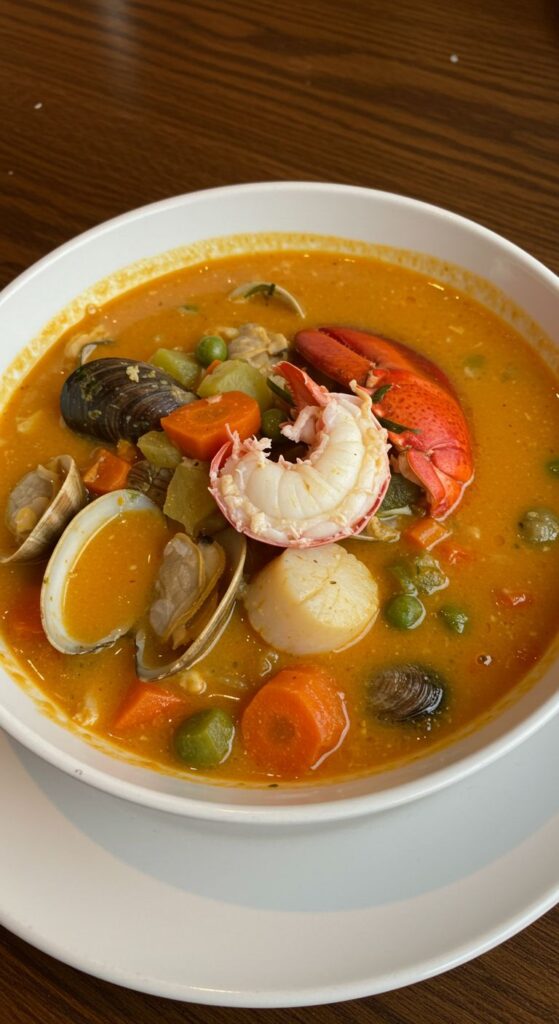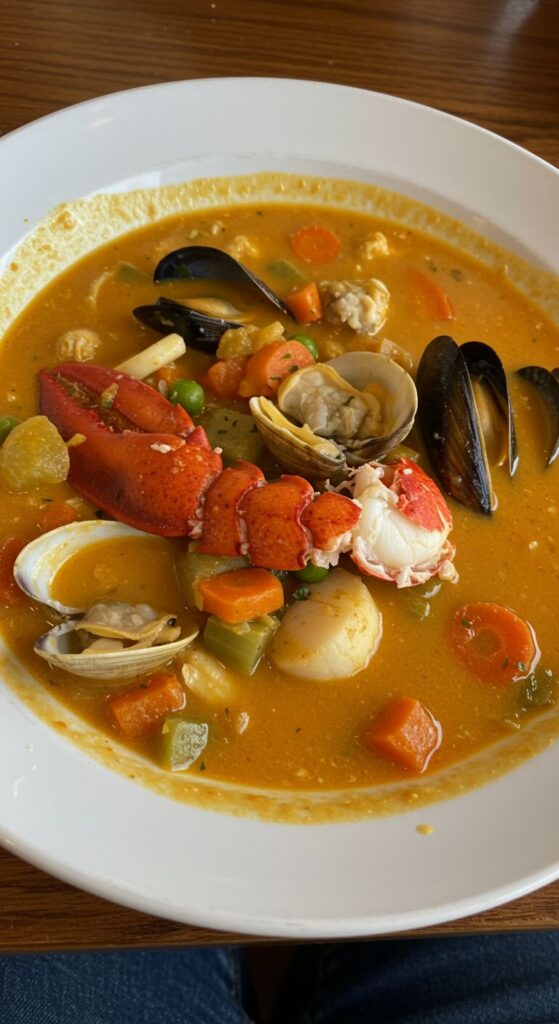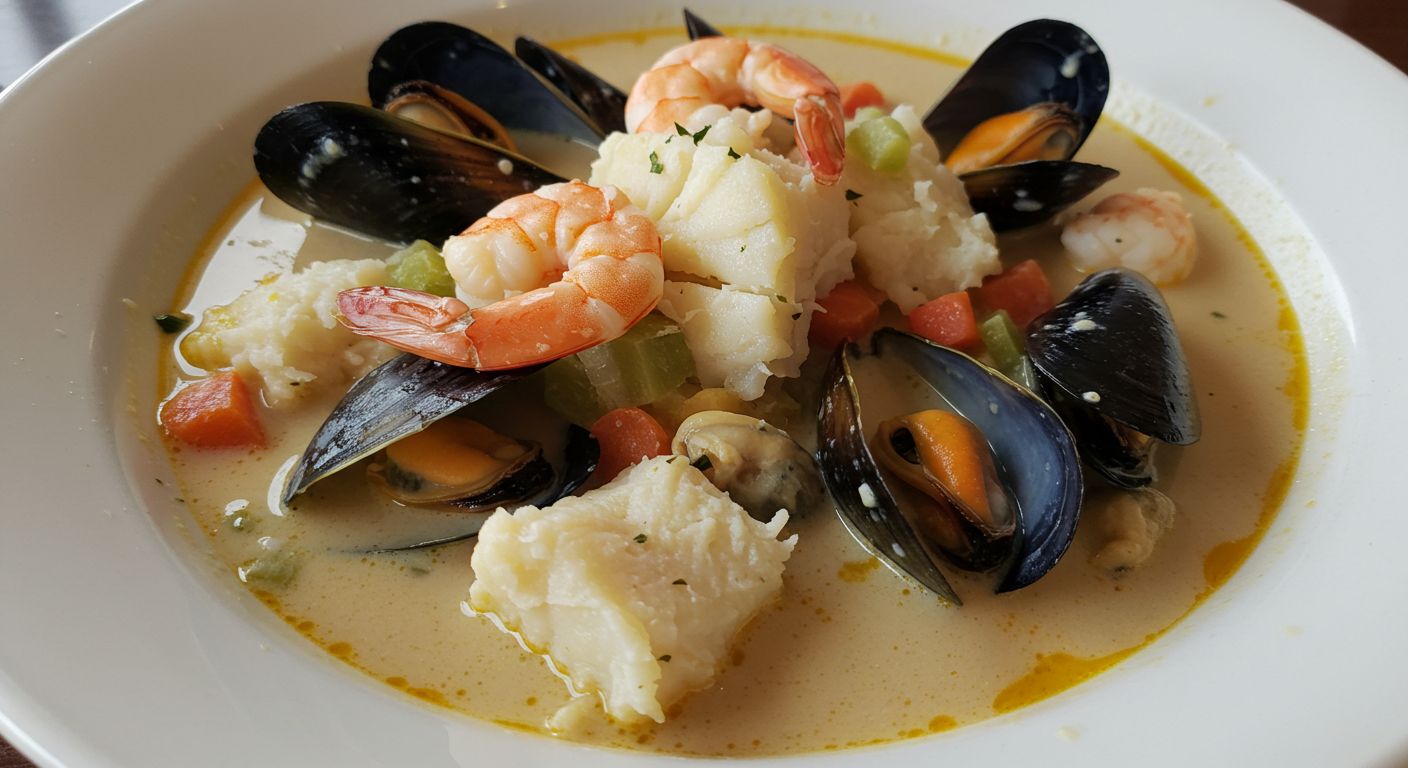
Table of Contents
The first time I tasted Nova Scotia seafood chowder, it was amazing. I was in a small coastal restaurant by the Atlantic. It felt like I was in Nova Scotia’s heart, enjoying their food traditions.
This chowder is special. It’s a love letter to the ocean. It has fresh seafood and a creamy base. It shows the skill of generations of cooks.
I grew up far from the Atlantic. But this chowder connected me to Nova Scotia’s culture. Its flavors, like local fish and scallops, show the creativity of Nova Scotian cooks.
Key Takeaways
- Nova Scotia seafood chowder is a classic Maritime cuisine staple
- The dish reflects generations of coastal cooking traditions
- Fresh, locally sourced seafood is key to its taste
- Chowder is more than food; it’s a cultural experience
- Every recipe has its own special twist
Understanding Maritime Seafood Chowder Tradition
The atlantic ocean chowder is more than food. It’s a journey through Nova Scotia’s rich history. It shows how a simple dish became a beloved tradition.
Fishermen in Nova Scotia started making these stews. They needed meals that lasted all day at sea. Their cooking made seafood into something amazing.
Roots of Maritime Culinary Heritage
Seafood traditions in Atlantic Canada are full of stories. The chowder was a way to enjoy the sea’s gifts. Early settlers used fresh seafood and local ingredients to make tasty meals.
- Fresh local seafood
- Simple cooking techniques
- Locally available ingredients
- Preservation methods passed through generations
Historical Culinary Significance
Chefs like Roland Glauser have made the chowder even better. At the Saltscapes Expo Chowder Cook-Off, Glauser showed how to update old recipes. His chowder used local drinks, showing the dish’s growth.
Recipe Evolution
The chowder has changed a lot over time. Now, it mixes old ways with new ideas. Chefs like Brad Wammes and Mark Gabrieau keep making it exciting, staying true to its roots.
Essential Ingredients for the Perfect Nova Scotia Seafood Chowder
Making a real east coast clam chowder needs special ingredients. These ingredients bring out the taste of Nova Scotian seafood. A good nova scotian seafood bisque uses fresh, top-quality parts to make a tasty soup.
Choosing the right seafood is key for a great chowder. My recipe uses the best sea foods. They add flavor and richness to every bite.
- Fresh Seafood Selection:
- 300 grams white fish filet (cod)
- 300 grams mini scallops
- 2 pounds fresh mussels
- 1 can (300 grams) frozen lobster meat
- Optional: 2-3 lobster tails
The cream and liquid parts are also important for the chowder. I suggest using:
- 2 to 2.5 cups of 18% cream
- 220 ml clam juice
| Ingredient Category | Nutritional Highlights |
|---|---|
| Seafood Protein | 46 grams protein per serving |
| Cream Base | 37 grams fat per serving |
| Vegetable Components | 55 grams carbohydrates per serving |
When making this east coast clam chowder, remember to use fresh ingredients. Local parts make the nova scotian seafood bisque even better. They connect you to Maritime cooking traditions.
Kitchen Tools and Equipment Needed
To make a real acadian seafood chowder, you need more than just good stuff. The right tools make a big difference. I’ll show you what you need to make a dish that’s truly memorable.
Essential Cookware for Perfect Chowder
The best chowder starts with the right pot. A large heavy-bottomed Dutch oven is key. It keeps the heat even and stops the seafood and sauce from burning.
- Heavy-bottomed Dutch oven (6-8 quart capacity)
- Cast iron or stainless steel stockpot
- Large wooden spoon for stirring
- Sturdy ladle for serving
Measuring and Preparation Tools
When making acadian seafood chowder, being precise is important. Right measurements mean the flavors and texture are just right.
| Tool Category | Recommended Items |
|---|---|
| Measuring Tools | Liquid measuring cups, dry measuring cups, kitchen scale |
| Cutting Tools | Sharp chef’s knife, cutting board, seafood shears |
| Preparation Tools | Mixing bowls, whisk, vegetable peeler |
Storage Solutions
After you make your chowder, keeping it fresh is important. Use airtight containers to keep the taste and quality good for later.
- Glass storage containers with tight-fitting lids
- Freezer-safe plastic containers
- Vacuum-sealed bags for long-term storage

Good kitchen tools make cooking better. With these, you’ll make a delicious acadian seafood chowder. It will honor Nova Scotia’s cooking traditions.
Selecting and Preparing Fresh Seafood

Making a real Nova Scotia haddock chowder or lobster chowder begins with fresh seafood. The quality of your ingredients is key to this dish.
When getting seafood for your chowder, remember these important points:
- Choose fresh or high-quality frozen seafood
- Look for bright, clear eyes on whole fish
- Check for a clean, ocean-like smell
- Ensure seafood is firm and not discolored
For a true Nova Scotia seafood chowder, mix different seafood. The best mix includes:
| Seafood Type | Quantity | Preparation Tip |
|---|---|---|
| Haddock | 300 grams | Cut into bite-sized chunks |
| Lobster | 300 grams | Remove meat from shell |
| Scallops | 300 grams | Pat dry before cooking |
Cleaning seafood needs careful steps. For lobster, gently take out the meat from the shell. Keep big pieces for looks. With haddock, remove bones and cut into even chunks for cooking.
Pro tip: If fresh seafood isn’t available, high-quality frozen seafood can be an excellent alternative for your Nova Scotia seafood chowder.
The Chowder Trail in Nova Scotia features nearly 60 stops for seafood chowder from May to October, showing the region’s seafood skills!
Base Preparation: Creating the Perfect Chowder Foundation
Making a great nova scotia seafood medley starts with a solid base. This base is key for a memorable meal. It needs careful attention and a good understanding of flavors.

The secret to a top nova scotia seafood medley is in its base. I’ll show you how to turn simple parts into a rich dish.
Making Lobster Stock
A strong lobster stock is the heart of a real seafood chowder. Here’s what you need:
- Fresh lobster shells
- Aromatic vegetables
- White wine
- Fresh herbs
Vegetable Base Preparation
The veggie base adds depth and complexity. Choosing the right veggies can make your chowder amazing.
| Vegetable | Preparation Technique | Flavor Impact |
|---|---|---|
| Onions | Finely diced, slow-sautéed | Sweet, foundational flavor |
| Celery | Minced, sweated | Aromatic base note |
| Potatoes | Cubed, par-boiled | Creamy texture |
Seasoning Techniques
Seasoning is an art that can change your chowder. Taste as you go and add Maritime herbs and spices.
- Fresh thyme
- Bay leaves
- Kosher salt
- Freshly ground black pepper
Learning these base steps will help you make a nova scotia seafood medley. It will show off Maritime cooking traditions.
Step-by-Step Cooking Process
Making a real maritime seafood soup needs care and precision. I’ll show you how to make a tasty Nova Scotia seafood chowder. It’s a true taste of Atlantic Canadian cuisine.
- Prepare the Base
- Dice bacon and fry until browned (about 5 minutes)
- Sauté onions and celery in bacon fat
- Add one clove of garlic for extra flavor
- Build the Liquid Foundation
- Pour in 2 jars of clam juice (8 oz each)
- Add potatoes and boil for 10 minutes to release starch
- Make a thickening base for the maritime seafood soup
- Seafood Integration
- Add seafood mix: 4 oz smoked salmon
- Include 8 oz wild salmon
- Mix in 8 oz white fish
- Add 16-24 large shrimp
- Optional: 12 scallops
- Final Touches
- Simmer seafood for 5-8 minutes
- Stir in 1 cup of 10% cream
- Heat to steaming over medium-low heat (10 minutes)
“The secret to an exceptional Nova Scotia seafood chowder lies in respecting the delicate nature of the seafood and allowing each ingredient to shine.”
By following these steps, you’ll make a rich, flavorful chowder. It’s full of protein and good nutrients. Each serving has about 411 calories. It’s a mix of proteins, carbs, and healthy fats.
Serving Suggestions and Accompaniments
Creating the perfect atlantic ocean chowder experience goes beyond the pot. The right accompaniments can make your east coast clam chowder unforgettable.
Selecting the Perfect Side Dishes
Here are some great side dish options for your seafood chowder:
- Crusty artisan bread (needs only four ingredients)
- Steamed asparagus for a light, fresh touch
- Twice-baked potatoes for a hearty addition
- Homemade slaw with a tangy dressing
Garnishing Like a Pro
Make your atlantic ocean chowder look amazing with these garnishing tips:
- Sprinkle fresh dill for a burst of herbal freshness
- Drizzle high-quality olive oil around the bowl
- Add pan-seared scallops as an elegant topping
- Garnish with finely chopped chives
Serving Temperature and Presentation
I suggest serving your east coast clam chowder right after you make it. Keep it hot but not boiling. This lets the rich flavors shine. A warm serving bowl helps keep it at the right temperature.
“The perfect chowder is a symphony of flavors, best enjoyed fresh and hot!”
Storage, Reheating, and Leftover Ideas
After making a tasty Nova Scotian seafood bisque, it’s important to store it right. Keep it in an airtight container in the fridge for up to 3 days. It often tastes even better the next day, as the flavors get richer.
When reheating, be gentle to keep it creamy and the seafood tender. Warm it over low heat, stirring now and then. Don’t boil it, as it can ruin the texture. A slow reheat keeps it as tasty as the first time.
Leftover chowder can be turned into something new and exciting. Use it as a pasta sauce, a filling for pot pies, or on seafood-topped toasts. These ideas help you enjoy it in new ways and reduce waste. Just remember to be creative and respect the dish’s original flavors.
FAQ
What makes Nova Scotia seafood chowder unique?
Nova Scotia seafood chowder is special because of its fresh Atlantic Ocean seafood. It uses haddock, lobster, and scallops. It also has a creamy base that shows off East Coast cooking.
Can I make the chowder with frozen seafood?
Yes, you can use frozen seafood. Choose high-quality, individually quick-frozen (IQF) seafood. Thaw it carefully and pat it dry for the best taste and texture.
How long can I store Nova Scotia seafood chowder?
Store the chowder in an airtight container in the fridge for 3-4 days. It tastes better the next day. Reheat it gently to keep the seafood tender.
What’s the best way to prevent the chowder from becoming too thick?
Add warm cream or fish stock slowly to keep it right. If it gets too thick, add a bit of warm liquid. Stir well to keep it creamy.
Can I make this chowder dairy-free?
Yes! Use coconut milk or a non-dairy cream instead of dairy. It will change the taste a bit. Choose full-fat for the best creamy texture.
What seafood combinations work best in the chowder?
Haddock is traditional, but mixing lobster, scallops, and shrimp is great. Choose seafood that tastes good together and shows off the Atlantic’s bounty.
How can I make the chowder more authentic?
Use local seafood and make your own fish stock. Add Maritime ingredients like salt pork or bacon. These details will make your chowder taste like it’s from Nova Scotia.
What are the best side dishes to serve with Nova Scotia seafood chowder?
Serve it with fresh bread, tea biscuits, or oyster crackers. A light green salad or crusty sourdough is also good. They add to the chowder’s rich flavor without overpowering it.

